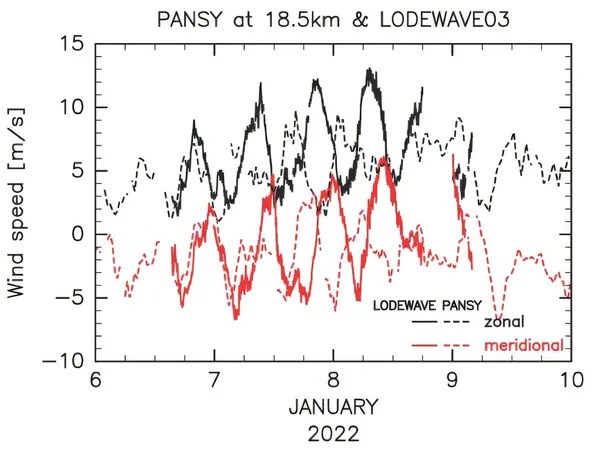
Major Flaws Exposed in Gravity Wave Models Over Antarctica – What It Means for Weather Predictions!
2024-12-27
Author: Sarah
Groundbreaking Research Unveils Shortcomings in Atmosphere Models
Groundbreaking research conducted by the Research Organization of Information and Systems (ROIS) in collaboration with other experts has unveiled serious shortcomings in how current atmospheric models simulate gravity waves over Antarctica. The study, published in the Journal of the Meteorological Society of Japan on September 2, emphasizes not only the complexity of these atmospheric phenomena but also their critical role in influencing weather patterns and climate systems.
Understanding Gravity Waves
Gravity waves, often compared to the ripples formed when a pebble is tossed into a pond, behave quite differently as they traverse the atmosphere. Although these waves are mostly invisible, they are instrumental in shaping weather conditions and can be responsible for turbulence experienced during flights. Climate scientists have been tirelessly working to understand and characterize these elusive waves.
Key Findings by Researchers
"We aimed to characterize the gravity waves we observed, assess how well they are represented in the latest reanalysis data from ERA5, and identify specific deficiencies in the models," remarked Yoshihiro Tomikawa, associate professor at ROIS and the lead author of the study.
ERA5 is known for its high-resolution atmospheric reanalysis, which integrates observational data into simulations, making it a cornerstone for climate research. However, from January to February 2022, the research team found limitations while conducting simultaneous observations using a super-pressure balloon and the PANSY atmospheric radar—both stationed at Syowa Station in Antarctica. Their observations revealed gravity waves with near-inertial frequencies (NIGWs) occurring in the lower stratosphere. Alarmingly, while ERA5 managed to qualitatively identify these NIGWs, it grossly underestimated their amplitude and missed key wave packets.
"Our findings indicate that even the most sophisticated general circulation models used for reanalysis fall short in accurately reproducing gravity waves and their effects," Tomikawa explained.
Simulation Shortfalls and Future Directions
The research identified that ERA5 struggles with simulating waves featuring very short vertical wavelengths and tracking their precise locations. This revelation underscores the critical intersection of direct observational data and atmospheric modeling, especially when it comes to accurately representing small-scale processes like gravity waves.
Addressing these simulation shortfalls will be essential for improving the accuracy of weather predictions and refining climate models. "We are committed to continuing our simultaneous observations with super-pressure balloons and PANSY radar. This will allow us to better understand the three-dimensional structure of gravity wave impacts over Antarctica by integrating observed data, theoretical models, and gravity wave theory," Tomikawa concluded.
Broader Implications
The implications of this research are vast; as scientists strive to enhance our predictive capabilities regarding weather and climate phenomena, understanding gravity waves may prove to be the key to unlocking more reliable forecasts in the future! Stay tuned as we follow the developments in this fascinating field!

 Brasil (PT)
Brasil (PT)
 Canada (EN)
Canada (EN)
 Chile (ES)
Chile (ES)
 Česko (CS)
Česko (CS)
 대한민국 (KO)
대한민국 (KO)
 España (ES)
España (ES)
 France (FR)
France (FR)
 Hong Kong (EN)
Hong Kong (EN)
 Italia (IT)
Italia (IT)
 日本 (JA)
日本 (JA)
 Magyarország (HU)
Magyarország (HU)
 Norge (NO)
Norge (NO)
 Polska (PL)
Polska (PL)
 Schweiz (DE)
Schweiz (DE)
 Singapore (EN)
Singapore (EN)
 Sverige (SV)
Sverige (SV)
 Suomi (FI)
Suomi (FI)
 Türkiye (TR)
Türkiye (TR)
 الإمارات العربية المتحدة (AR)
الإمارات العربية المتحدة (AR)